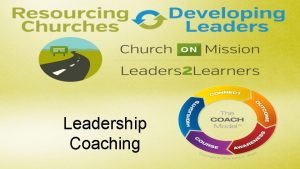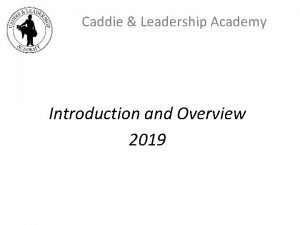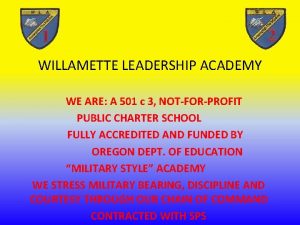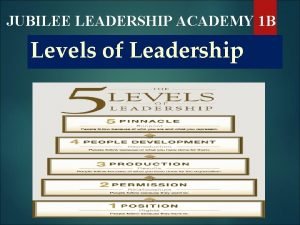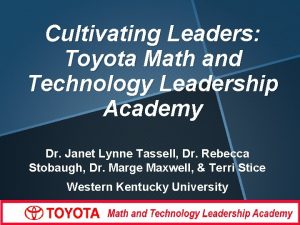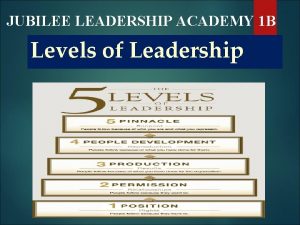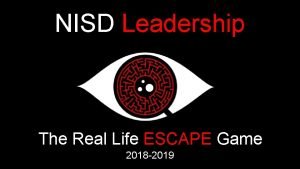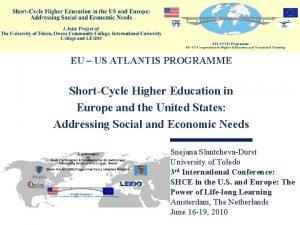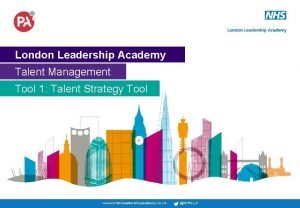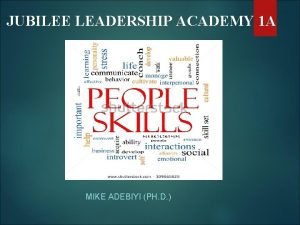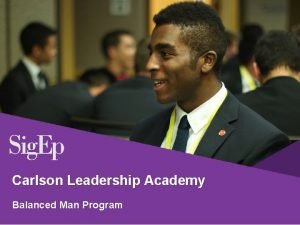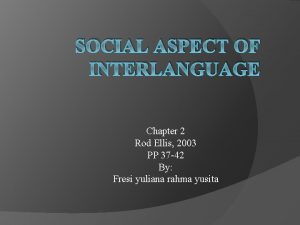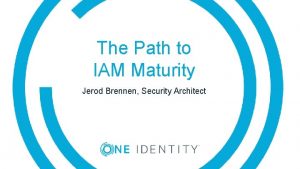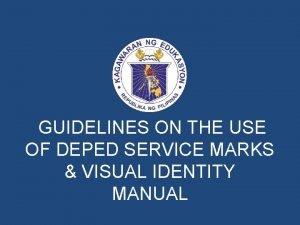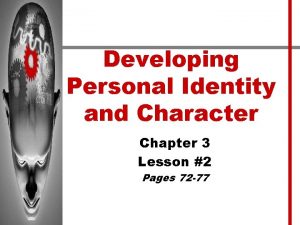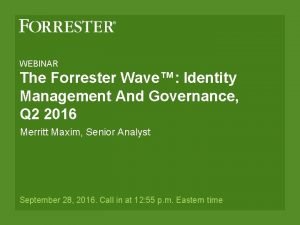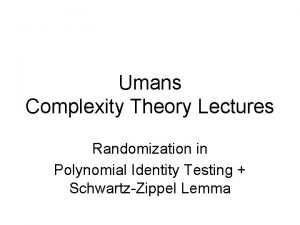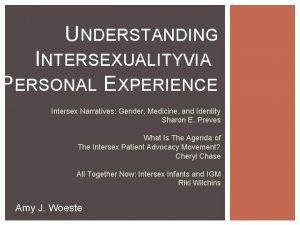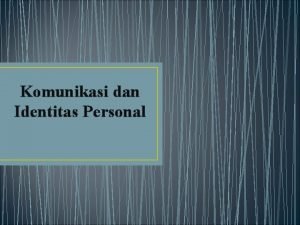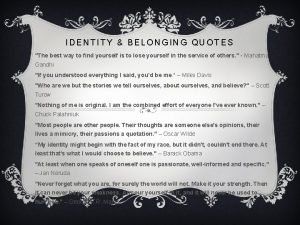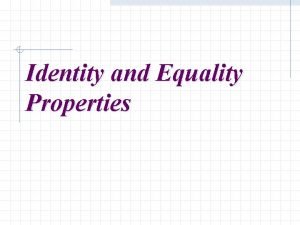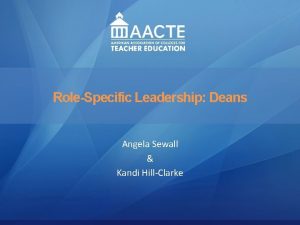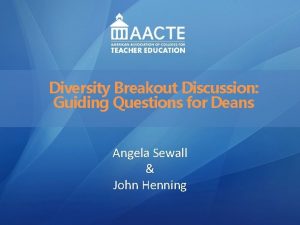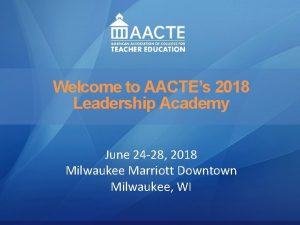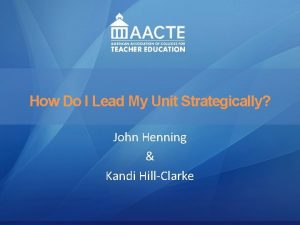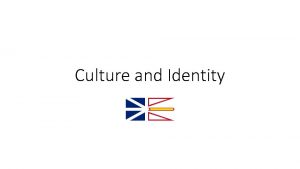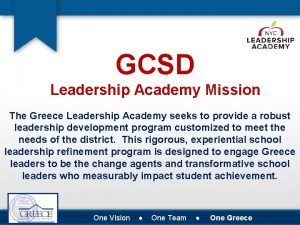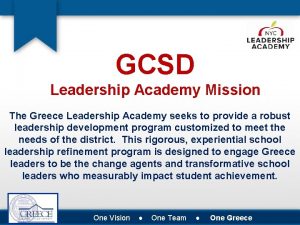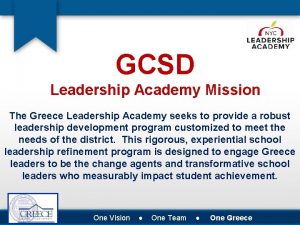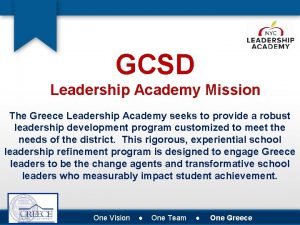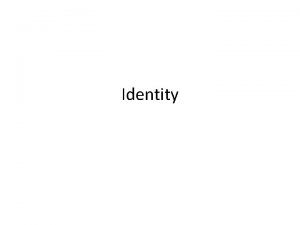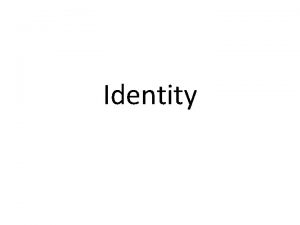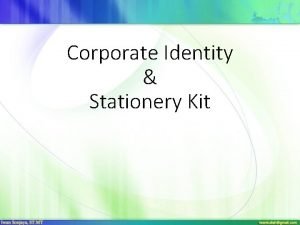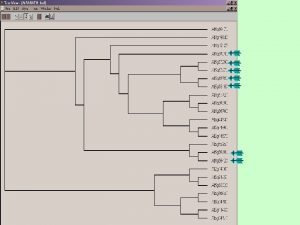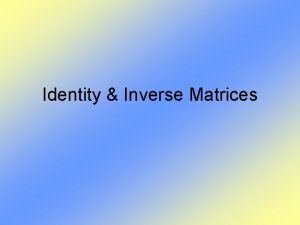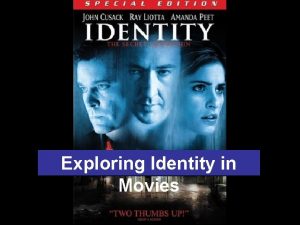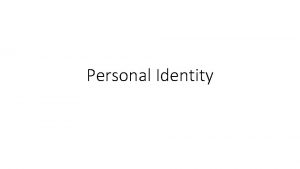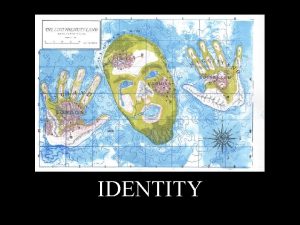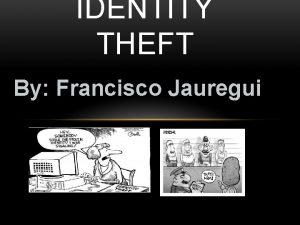Leadership and Identity AACTE Leadership Academy What is
































- Slides: 32

Leadership and Identity: AACTE Leadership Academy What is a Leader and Who am I as a Leader? Renee A. Middleton, Ohio University Walt Gmelch Angela M. Sewall, UALR & Angela Sewall

Learning Outcomes 1. Know yourself and your personality structure. 2. Identify effective leadership strategies in working with and leading generational cohorts. 3. Identify and explore the four frames of leadership. 4. Apply the frames of leadership to your academic setting. American Association of Colleges for Teacher Education

Developing Academic Leaders: Five Assumptions Guiding This Session 1. Leaders cannot be created in a conference. 2. Leading is learning on the job, enhanced by a variety of experiences and challenges. 3. Leaders can make meaning of their experience by reflecting on it personally and sharing it with their colleagues. 4. Learnings must be carried to, and applied back, at the workplace. 5. Theoretical frameworks can help make sense of leadership experiences. American Association of Colleges for Teacher Education

Know Yourself • What are your areas of deep knowledge and expertise? • What is your preferred mode of communication? (Written, oral, face to face, on-line? ) • What generation do you represent? – Traditional, Baby Boomer, Gen X, Ne. XT? – What generation is represented by your faculty, colleagues and students? American Association of Colleges for Teacher Education

What is your Personality Structure? What is the Structure of Those with Whom you Work? – What is your preferred mode of communication? – What is the channel in which you would like to give and receive communication? – What is the preference of the individuals with whom you work and whom you serve? • Rebel- Funster– spontaneous, creative and playful – energetic and enthusiastic • Workaholic – Thinker - capacity for organization and detailed planning, logical and responsible • Persister –Believer– dedicated, observant and conscientious • Dreamer – Imaginer – calm imaginative and reflective • Reactor – aka Harmonizer or Feeler –nurturing, empathetic creator of harmony • Promoter – Do-er– adaptable, persuasive and charming, very resourceful From ASCD - Classroom Leadership, September 1999 | Volume 3 | Number 1 American Association of Colleges for Teacher Education

As Leaders (and Teachers) There are six simple questions that we can ask: 1. How can I build recognition for work and time structure into this (for the Thinker) 2. How can I ensure the task is meaningful? (for the Believer) 3. How can I make this fun? (for the Funster) 4. How can I incorporate action? (for the Do-er) 5. How can I provide reflection time? (for the Dreamer) 6. How can I provide personal recognition and opportunities to interact with others? (for the Feeler) Source: ASCD American Association of Colleges for Teacher Education

Know Those with Whom you Work • Process Communication provides a reliable and validated method of identifying and understanding personality structures, the impact of life events, and communication dynamics. • Based on a scientific award–winning clinical discovery Process Communication has been researched through thirty years and experienced by almost a million people on five continents in such applications as sales, business, education, politics, religion, medicine, parenting, and personal relationships. Developed by Dr. Taibi Kahler. American Association of Colleges for Teacher Education

Personality Structure Each of us has the need to: 1. Appreciate values like the Persister; 2. Possess the spontaneity of the Rebel; 3. Has the compassion and warmth of a Harmoniser; 4. Use the ability to be logical as does a Thinker; 5. Enjoy the experience of taking a risk as can a Promoter; and 6. Has some of the calm that the Imaginer shows. In PCM we do not therefore, speak of types of people, but types in people. However we each have one or sometimes two personality types more obvious in us than others. http: //www. processcommunication. lu/model. php American Association of Colleges for Teacher Education

Generational Cohorts Each of us falls somewhere in this framework. Products of our time Culturally influenced perspectives Generational traits “Traditionals” – value discipline thrift and duty, not here to have a good time. • Silent Generation- (1925 -1945) – refers to people who were born between 1925 and 1945. There are several theories as to where the label 'Silent Generation' originated. The children who grew up during this time worked very hard and kept quiet. It was commonly understood that children should be seen and not heard. • “Boomers” – pre-digital, non-conformists, conflict averse, interactive, collegial, cooperative, like higher order learning and move from theory to action. • • • American Association of Colleges for Teacher Education

Generation Ne. Xt Adaptable, pragmatic, scrappy Family revolves around them Parents as facilitators not authority figures Do not always accept responsibility for their own learning… • Like praise, defensive about criticism, • Self- important but someone else’s job to teach them, not their job to “learn” • Importance of involving the parents • • – Mark L. Taylor. Generation Ne. Xt: Today’s Postmodern Student. Meeting, Teaching and Serving. American Association of Colleges for Teacher Education

Millennials (ages 23 -35) • • • More diverse More inclusive Value diversity Hyper alert to micro-aggressions Communication has become very delicate Different Relationship with Technology – Search is learning – Find is know Howard Gardner and Katie Davis. (The App Generation) American Association of Colleges for Teacher Education

Generation 2. 0 or Gen. Z Born Completely within the TECH age First Truly Global Tend to be brash, narcissistic and entitled Hard working, anxious and future mindful Take in info quickly but lose interest just as fast Want respect. They are participation generationthe awards generation. • Had family influence so when they work, they expect to be consulted on ALL workplace decisions. • • • American Association of Colleges for Teacher Education

At College… • Literacy is among college graduates is declining… • Many who earn degrees have not mastered the reading, writing and thinking skills we expect. – Spellings Commission on the Future of Higher Education (August, 2009) – Rum, Richard and Roksa, Josipa – “Academically Adrift” American Association of Colleges for Teacher Education

Change…. • Need to connect faculty to the workplace – Move from listeners to active producers – Match instruction with desired outcomes – Engage Ne. Xt learners affectively and explain the “Whys” or learning and practice, – Need to connect digital lives to learning lives and work – Classes and communication must change…. . – To active, engaged, responsible learning – not passive, learning must be connected, application and evaluation, leverage technology in and outside of class/work. American Association of Colleges for Teacher Education

Working as a Middle Manager…. • • Ability to link goals Assume good will Model best practice Offer transition plans How do authority, consensus building, and vision intersect with your work and your role as a middle manager and as a LEADER? American Association of Colleges for Teacher Education

Which is your Most Comfortable Approach? • To others – – In similar roles, – For whom you work – What are your responsibilities? – What responsibilities cross roles? American Association of Colleges for Teacher Education

Do you Truly Lead or Like to Manage? • As a leader, management must be left to others or conducted “after hours”… American Association of Colleges for Teacher Education

Keys to Effective Academic Leadership • Building a community of colleagues • Setting direction (vision, goals and measureable objectives) • Empowering others and encouraging professional development • Ensuring the conflict is constructive and even collegial • Willingness to share and make decisions and own them • Provision of leadership and all that it entails American Association of Colleges for Teacher Education

Leadership Frames • • • Different vantage points Windows on the world Lenses that bring world into focus Filter some things out – others pass through Help order experience and decide action to take American Association of Colleges for Teacher Education

The Power of Reframing • The Structural Frame - organizational goals and roles - rules, policies, hierarchies • The Human Resource Frame - people and organization interdependence - fit between individual’s needs, skills, and values with - formal roles and relationships • The Political Frame - power, conflict and resources - use power, coalitions, bargaining • The Symbolic Frame - images, drama, magic - rites, rituals, story tellers American Association of Colleges for Teacher Education

Leadership Frames Inventory 1. Predict what your most used and least used frame of leadership. 2. Complete the Frames of Leadership Inventory 3. Plot your scores on the Frames Diagram. 4. Compare your scores with others at the table. 5. What are the advantages and disadvantages of each of the frames? American Association of Colleges for Teacher Education

Architect or Tyrant? Effective Structural Leaders: • Do their homework • Develop a new model (structure, strategy, & systems) • Focus on implementation • Continually, experiment, evaluate and adapt American Association of Colleges for Teacher Education

Catalyst or Wimp? Effective Human Resource Leaders: • Believe in people and communicate that belief • Are visible and accessible • Empower their people American Association of Colleges for Teacher Education

Empowerment Warren Bennis 1990 American Association of Colleges for Teacher Education

Prophet or Zealot? Effective Symbolic Leaders: • Use symbolic to capture attention • Provide interpretations of experience • Discover and communicate a vision • Tell stories American Association of Colleges for Teacher Education

Advocate or Con Artist? Effective Political Leaders: • Clarify what they want – and what they can get • Assess the distribution of power and interests • Build linkages to other stakeholders • Persuade first, negotiate second, and use coercion only if necessary American Association of Colleges for Teacher Education

Overview of the Four Frames Model: American Association of Colleges for Teacher Education

How Does your Style Mesh with Others and with the Institution? • Bolman and Deal, Reframing Organizations – Structural – Political – Symbolic – Human Relations • How does personal style and organizational frame mesh? • Where are you MOST comfortable? How can you develop sensitivity to other approaches? American Association of Colleges for Teacher Education

How will You Lead? • How would your superiors say that you lead? • How would your fellow chairs/deans/associate deans say that you lead? • How would your faculty say that you lead? • What would your friends /significant others say? American Association of Colleges for Teacher Education

Successful Academic Leaders How can you assure your success as an academic leader? Create campus arrangements and reporting relationships that offer clarity and facilitate work Create caring and productive campus environments that channel talent and encourage cooperation Respect differences, manage them productively, and respond ethically and responsibly the needs of multiple constituencies Infuse everyday efforts with energy and soul American Association of Colleges for Teacher Education

Foundations of Visioning • Preserve what makes the SCDE unique in terms of values. • Engage in a process that will involves all key stakeholders. • Galvanize broad support for the process and its outcomes. • Honor and celebrate the SCDE’s prior successes. American Association of Colleges for Teacher Education

The Future • Long or short term… – What are my greatest challenges in leadership? • In the organization, in my organizational role, personally? • Where would I like to be in 2, 5 or 10 years? • What is my road map to get there? • What are signposts of success? • What are the hazards on the road? • What leader would I most like to emulate? American Association of Colleges for Teacher Education
 Aacte leadership academy
Aacte leadership academy Identity map
Identity map Breakthrough shadow coaching
Breakthrough shadow coaching Caddie and leadership academy
Caddie and leadership academy Willamette leadership academy middle school
Willamette leadership academy middle school Diversity executive leadership academy
Diversity executive leadership academy Jubilee leadership academy
Jubilee leadership academy Toyota leadership academy
Toyota leadership academy Jubilee levels
Jubilee levels Nisd leadership academy
Nisd leadership academy Atlantis leadership academy
Atlantis leadership academy London leadership academy
London leadership academy Jubilee leadership academy
Jubilee leadership academy Balanced man program
Balanced man program Transformational vs transformative leadership
Transformational vs transformative leadership Adaptive leadership
Adaptive leadership Adaptive leadership vs situational leadership
Adaptive leadership vs situational leadership Stylistic continuum
Stylistic continuum Stylistic continuum in interlanguage
Stylistic continuum in interlanguage Security maturity model gartner
Security maturity model gartner Commutative associative distributive properties
Commutative associative distributive properties Bred in south auckland poem
Bred in south auckland poem Deped order visual identity manual
Deped order visual identity manual Gender-role development
Gender-role development Your personal identity who are you
Your personal identity who are you Developing personal identity and character
Developing personal identity and character Your conscious awareness of your own name
Your conscious awareness of your own name Forrester wave identity management and governance
Forrester wave identity management and governance Schwartz-zippel lemma and polynomial identity testing
Schwartz-zippel lemma and polynomial identity testing Intersex and identity sharon e. preves
Intersex and identity sharon e. preves Personal : kelompok =
Personal : kelompok = Quotes about identity and belonging
Quotes about identity and belonging Identity property geometry
Identity property geometry


